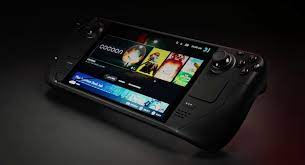Introduction
In the ever-growing market of handheld gaming PCs, newer devices keep promising more power, higher resolution displays, and larger batteries. Yet despite that competition, the Steam Deck OLED remains one of the best all-round values for real-world gaming in 2025. In this article we’ll explore exactly why it continues to beat many rivals—not necessarily by raw specs alone—but by smart balance: display quality, ecosystem strength, serviceability, value, and long-term support.
What sets the Steam Deck OLED apart
1. Outstanding display for the price
The OLED version of the Steam Deck upgrades the display to a 7.4-inch HDR OLED panel with a 90 Hz refresh rate, compared to the original LCD model. Tom’s Hardware+1 Reviewers measured coverage of 101.8% of DCI-P3 and 143% of sRGB gamut. Tom’s Hardware Deep blacks, excellent contrast and rich colour rendition make it visibly better than many handhelds.
For many users, excellent visuals mean more than just higher resolution or raw performance.
2. Balanced hardware and price
While some newer handhelds push higher resolution, bigger batteries or more cores, the Steam Deck OLED strikes a strong middle ground of performance and cost. For example, its price starts around $549 for the 512 GB model in many markets. The Verge+1
A device that’s performance-adequate with great value remains very competitive.
3. Mature ecosystem and software experience
One big advantage is the mature ecosystem. The Steam Deck runs SteamOS, supports thousands of titles, has verified compatibility, docks easily, and has broad accessory support. Reviewers highlight that this experience still surpasses many newer handhelds with raw spec advantage but less software polish. PC Gamer+1
For real-world gaming (especially for non-tinkerers), this matters more than a few extra frames.
4. Serviceability and long-term support
Another current strength: the Steam Deck is known to be relatively service-friendly. Parts, user-replaceable SSDs, community repair guides exist, and this builds confidence in longevity. PCGamer notes it remains a good value partly because of maintainability. PC Gamer
In 2025, when many high-end handhelds are premium and niche, this broad service ecosystem gives the Deck an edge.
5. Battery life improvements and real-world usability
The OLED version also brought battery life gains: Valve claimed improved endurance (3–12 hours depending on usage). Alex Reviews Tech Reviewers found that while heavy AAA titles still drain fast, for typical indie games and mid-tier settings the device offers solid battery life and portability. That balance (not longest possible battery, but good enough) helps it stay relevant.

Real-world gaming: why these factors matter
- Display quality affects immersion: vibrant colours, deep blacks, and correct refresh rates matter more to many gamers than raw 1080p or higher resolution which may be under-utilised due to power or thermal constraints.
- Price/value ratio: A great handheld at the right price beats a more expensive one that demands compromises (battery, heat, size) simply because you get less real use-time.
- Software/compatibility: Having the library, smooth OS, docking and accessory support makes for less frustration. A handheld that “just works” for your library is more appealing than one you must tweak heavily.
- Repair/service lifespan: Portability means more wear & tear. Devices that are easier to maintain, update and keep alive longer create better value over time.
- Form-factor and portability: Raw power must be balanced with size, heat, noise and battery; too big or too hot kills the handheld experience.
Areas where the Steam Deck OLED isn’t perfect
Of course, it’s not flawless. Some reviewers point out:
- The resolution remains 1280×800 (SDR) in many models, meaning sharper handheld consoles at same size may offer higher resolution. TechRadar
- For top-tier AAA titles with high settings, the Deck may lag some of the ultra-premium handheld PCs in frame-rates. TechRadar+1
- Battery life under maximum load is still limited by physics and handheld size.
But the point is: the Steam Deck OLED picks the right compromises for the majority of real users, rather than chasing the absolute top spec and losing usability/price.
Why in 2025 it still leads the pack
- Because many newer handhelds emphasise performance, but raise cost and/or battery/thermal trade-offs, the Steam Deck OLED’s balance is attractive.
- The ecosystem maturity means fewer surprises, updates and third-party accessories.
- Its service/support and user community remains strong—important for long-term value.
- Its display upgrade and price point still less matched by newer entrants given their higher cost and early-adopter issues.
- Reviews in 2025 consistently label it as one of the best value gaming handhelds. PC Gamer+1
Final verdict
If you’re looking for a handheld that offers excellent display quality, strong software support, reasonable price, and real-world portability in 2025, the Steam Deck OLED remains one of the top choices. It may not have the absolute highest resolution or the most extreme hardware specs, but it excels where it counts: in user experience, usability and value.
For gamers who demand every last frame and ultra-high resolution, other devices may make sense. But for most who want “great handheld gaming” now, it still beats many of the alternatives. In short: the Steam Deck OLED isn’t just still relevant in 2025—it remains a benchmark.